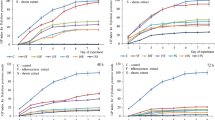Abstract
Greenhouse and laboratory experiments were conducted at the Agricultural and Water Resources Research Center Station, Baghdad, in 1985 and 1986 to investigate the possible allelopathic potential of alfalfa (Medicago saliva L.) and its decomposed residues on bladygrass (Imperata cylin-drica L. Beauv.), a noxious weed in Iraq, and to isolate, characterize, and quantify possible allelopathic agents in alfalfa residues and root exudates. Results indicated that decomposed alfalfa roots and their associated soil produced a 51–56% reduction in bladygrass seed germination. Root and shoot length of bladygrass seedlings were reduced by an average of 88%. Decayed and undecayed mixtures of alfalfa roots and soil at 0.015∶1 (w/w) inhibited bladygrass seedlings reproduced from rhizomes by 30 and 42%. It was found that root exudates of alfalfa seedlings caused significant reduction in shoot and root dry weights of bladygrass seedlings when alfalfa and bladygrass were grown together in nutrient culture. Caffeic, chlorogenic, isochloro-genic,p-coumaric,p-OH-benzoic, and ferulic acids were detected in alfalfa root exudates and residues. The highest amount (126 fig phenolic acids/g soil) of these compounds was found in alfalfa root residues after six months of decomposition in soil.
Similar content being viewed by others
References
Abdul-Rahman, A.A.S., andAl-Naib, F.A.G. 1986. The effects of bermudagrass (Cynodondac-tylon L. Pers.) on germination and seedling growth of cotton and three weed species.J. Agric. Water Resour. Res. 5:115–127.
Al-Juboory, B.K. 1978.Imerata cylindrica (L.) Beauv. Ecotypes in Iraq, some physiological aspects, and control by herbicides. PhD Dissertation. University of Baghdad.
Al-Saadawi, I.S., andRice, E.L. 1982. Allelopathic effects ofPolygonium avicular L. 1. Vegetational patterning.J. Chem. Ecol. 8:993–1009.
Al-Saadawi, I.S., Al-Uquili, J.K., Alrubeae, A.J., andAl-Hadithy, S.M. 1986. Allelopathic suppression of weeds and nitrification by selected cultivars ofSorghum bicolor (L.) Moench.J. Chem. Ecol. 12:209–220.
Blum, U., Dalton, B.R., andShann, J.R. 1985. Effects of various mixtures of ferulic acid and some of its microbial metabolic products on cucumber leaf expansion and dry matter in nutrient culture.J. Chem. Ecol. 11:619–641.
Dzubenko, N.N., andPetrenko, N.I. 1971. On biochemical interaction of cultivated plants and weeds, pp. 60–66,in A.M. Grodzinsky (ed.). Physiological-Biochemical Interactions in Phy-tocenosis, Vol. 2. Naukova Dumka, Kiev (in Russian).
Fay, P.K., andDuke, W.B. 1977. An assessment of allelopathic potential inAvena germplasm.Weed Sci. 25:224–228.
Guenzi, W.D., andMcCalla, T.M. 1966. Phenolic acids in oats, wheat, sorghum and corn residues and their phtotoxicity.Agron. J. 58:303–304.
Guenzi, W.D., Kehr, W.R., andMcCalla, T.M. 1964. Water soluble phytotoxic substances in alfalfa forage: Variation with variety, cutting, year, and stage of growth.Agron. J. 56:499–500.
Hoagland, D.R., andArnon, D.I. 1950. The water-culture method for growing plants without soil.Calif. Agric. Exp. Stn. Manual 347(rev. ed.): 32 pp.
Holme, L.G.,Plucknett, D.L.,Pancho, J.V., andHerberger, S.P. 1977. The World's Worst Weed: Distribution and Biology. The University Press of Hawaii.
Kommedahi, T.K., Kotheimer, J.B., andBernardini, J.V. 1959. The effect of quackgrass on germination and seedling development of certain crop plants.Weeds 7:1–12.
Lawrence, T., andKilcher, M.R. 1962. The effect of fourteen root extracts upon germination and seedling length of fifteen plant species.Can. J. Plant Sci. 42:308–313.
Leather, G.R. 1983. Sunflowers (Helianthus annuus) are allelopathic to weeds.Weed Sci. 31:37–42.
McPherson, J.K., Chou, C.H., andMuller, C.H. 1971. Allelopathic constituents of the chaparral shrubAdenostoma fasciculatum.Phytochemistry 10:2925–2933.
Miller, D.A. 1983. Allelopathic effects of alfalfa.J. Chem. Ecol. 9:1059–1072.
Nielsen, K.F., Cuddy, T.F., andWoods, W.B. 1960. The influence of the extract of some crops and soil residues on germination and growth.Can. J. Plant Sci. 40:188–197.
Overland, L. 1966. The role of allelopathic substances in the “smother crop” barley.Am. J. Bot. 53:423–432.
Pearson, D. 1970. The Chemical Analysis of Food, 6th ed. J & A Churchill, London.
Putnam, A.R., andDuke, W.B. 1974. Biological suppression of weeds: Evidence of allelopathy in accessions of cucumbers.Science 185:370–372.
Rice, E.L. 1979. Allelopathy—an update.Bot. Rev. 45:15–109.
Rice, E.L. 1984. Allelopathy, 2nd ed. Academic Press, Orlando, Florida. 422 pp.
Rose, S.J., Burnside, O.C., Specht, J.E., andSwisher, B.A. 1984. Competition and allelopathy between soybeans and weeds.Agron. J. 76:523–528.
Tsuzuki, E., andKawagoe, H. 1984. Studies on allelopathy among higher plants.Bull. Fac. Agric. Miyazaki Univ. 31:189–196.
Author information
Authors and Affiliations
Rights and permissions
About this article
Cite this article
Abdul-Rahman, A.A., Habib, S.A. Allelopathic effect of alfalfa (Medicago sativa) on bladygrass (Imperata cylindrica). J Chem Ecol 15, 2289–2300 (1989). https://doi.org/10.1007/BF01012082
Received:
Accepted:
Issue Date:
DOI: https://doi.org/10.1007/BF01012082




